emple of Majapahit
 The
archaeological sites of Majapahit consist, for
the most part, of the remains of religious foundations,
or candi, built usually from stone or brick.
From the two most important and informative literary
sources dealing with the history of Majapahit,
the Nagarakertagama and Pararaton, we learn that
a large number of sacred buildings were constructed
as memorial shrines to deceased rulers and their
families. The death of a king or queen saw the
beginning of a series of funeral rites designed
to guide the departed soul back to the source
from which it had originated. These rites culminated
in the shraddha ceremony, held 12 years after
death, upon completion of which it was believed
that final liberation was ensured. In memory
of the deceased,a stone image of a god or goddess,
with whom the ruler had been identified in life,
was fashioned as an 'ideal portrait' and placed
within a shrine. The Nagarakertagama gives a
very complete description of the sbraddha ceremony
conducted on behalf of the Rajapatni, grandmother
of King Hayam Wuruk, in the year 1362.
The
archaeological sites of Majapahit consist, for
the most part, of the remains of religious foundations,
or candi, built usually from stone or brick.
From the two most important and informative literary
sources dealing with the history of Majapahit,
the Nagarakertagama and Pararaton, we learn that
a large number of sacred buildings were constructed
as memorial shrines to deceased rulers and their
families. The death of a king or queen saw the
beginning of a series of funeral rites designed
to guide the departed soul back to the source
from which it had originated. These rites culminated
in the shraddha ceremony, held 12 years after
death, upon completion of which it was believed
that final liberation was ensured. In memory
of the deceased,a stone image of a god or goddess,
with whom the ruler had been identified in life,
was fashioned as an 'ideal portrait' and placed
within a shrine. The Nagarakertagama gives a
very complete description of the sbraddha ceremony
conducted on behalf of the Rajapatni, grandmother
of King Hayam Wuruk, in the year 1362.
It appears that more important rulers often
had monuments built in several places, and were
further identified with more than one divine
image. Thus, King Wishnuwardhana of singosari
Shiwa at Waleri (Blitar) and as Amoghapasha (a
Buddhist form) at Candi Jajaghu, east of Malang.
Likewise, his son and successor, Kertanagara,
had memorial shrines built at Pandaan (Candi
Jawi) and at Singosari. The Pararaton is especially
informative concerning the names and locations
of the shrines dedicated to the royal families
of Singosari and Majapahit ( see page 158).
The word candi, which is commonly used to identify
ancient remains dating from Indonesia's classical
period, needs some explanation. The term is generally
accepted today as stemming from the sanskrit
candika, a name of the Hindu goddess Durga, who
inhabits the graveyard. Technically speaking,
therefore candi is used to denote an ancient
tomb or shrine.In reality, however, we find the
word employed in a much wider context, and nowadays
it is applied to all manner of archaeological
sites, including gateways and bathing places.
In a contemporary context, then, a candi may
be seen as a place containing a residing spirit,
revered for both its age as well as its qualities
of mystery. In this sense, it is not different
to a pusaka, or sacred heirloom.
The Nagarakertagama differentiates four types
of sacred building, but it is difficult to know
with certainty which ones among them are properly
candi and which are not. It has been suggested
that buildings referred to as dharma baji, of
which 27 are listed, may be considered as royal
shrines. These include Kagenengan, Tumapel, Kidal,
Jajaghu, Weda-wedwan, Tudan, Pikatan, Bukul,Jawa-jawa,
Antang, Antasari, Kalangbret,Jaga, Balitar, Cilabrit,
Waleri, Babeg, Kukap, Lumbang, Pagor, Antahpura,
Segala, Simping, Ranggapura, Buddhi Kuncir, Prajnaparamitapuri
and Bhayalango.
Of the above-mentioned, the only ones which
we can identify with certainty today are Tumapel
(Singosari), Kidal, Jajaghu (Jago), Jawa-jawa
(Jawi), Simping (Sumberjati) and Bhayalango.
Kagenengan and Antahpura are known from literature
as being connected with Ken Angrok and Kertarajasa
respectively, but the exact locations of these
places are not yet known.
Architectural Styles
 Surveys
of East Javanese temple architecture usually
begin with Candi Kidal, which lies to the south
east of Malang. Built around the mid 13th century,
Kidal is the earliest known example of a new
stylistic tendency; a move away from the massive
structures which characterized the monuments
built by the Sailendra dynasty in Central Java
some four centuries earlier, towards more slender
buildings with tall, tapering spires. True, we
see a foreshadowing of this new style in the
Central Javanese temple complex of Prambanan,
but the almost total absence of archaeological
remains from the intervening period makes it
difficult to re-construct any coherent development
of architectural design between, say, A.D. 930,
when the centre of Javanese political power shifted
to the east, and about 1250, the approximate
date for the building of Candi Kidal.This new
style is quite clearly apparent in a number of
other monuments of the 13th and 14th centuries,
among them Candi Jawi, Candi Sawentar, Candi
Sumberjati (Simping), Candi Bangkal, Candi Bajang
Ratu, as well as the 'dated' temple at Penataran.
Surveys
of East Javanese temple architecture usually
begin with Candi Kidal, which lies to the south
east of Malang. Built around the mid 13th century,
Kidal is the earliest known example of a new
stylistic tendency; a move away from the massive
structures which characterized the monuments
built by the Sailendra dynasty in Central Java
some four centuries earlier, towards more slender
buildings with tall, tapering spires. True, we
see a foreshadowing of this new style in the
Central Javanese temple complex of Prambanan,
but the almost total absence of archaeological
remains from the intervening period makes it
difficult to re-construct any coherent development
of architectural design between, say, A.D. 930,
when the centre of Javanese political power shifted
to the east, and about 1250, the approximate
date for the building of Candi Kidal.This new
style is quite clearly apparent in a number of
other monuments of the 13th and 14th centuries,
among them Candi Jawi, Candi Sawentar, Candi
Sumberjati (Simping), Candi Bangkal, Candi Bajang
Ratu, as well as the 'dated' temple at Penataran.
A further development occurred in spatial orientation.
In the classical architecture of Central Java,
the layout of a temple or temple complex tended
to be symmetrical, with the principal building
situated in the centre, almost invariably aligned
with the cardinal points. The whole was conceived
as an earthly reflection of the subtle regions
inhabited by the gods, according to the principles
of Hindu and Buddhist cosmology. With the temples
of East Java, however, there appears to have
been a move away from this closed, centrally
focussed orientation, to one where the most important
and sacred building was placed at the rear of
the complex, furthest from the entrance.
We see a clear example of this idea at Candi
Penataran, where the site is divided into three
separate courtyards, into which a variety of
buildings have been placed in a seemingly haphazard
fashion. Symmetry has been all but abandoned.
The principal building, which faces west, can
be found at the far eastern end of the compound.
It has frequently been noted, incidently, that
Penataran appears to have been a prototype for
the modern day Balinese pura, which usually consists
of three courtyards, known as jaba, jaba tengah,
and jeroan, The temple is essentially a consecrated
space enclosed and protected by its surrounding
wall.
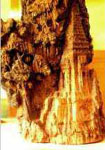 One
temple which is often considered to contain elements
of both early and late classical Javanese design
is Candi Singosari. In that it has a symmetrical
base with four projections aligned with the cardinal
points, the temple follows a pattern commonly
found in the Shiwaite monuments of Central Java.
Yet there are marked differences, the most notable
of which is the location of the four main chambers
or niches containing statues. In Central Javanese
temples these were almost invariably recessed
into the main body of the building, which rested
on a solid base. At Singosari, however, the niches
have been set into the base itself, perhaps with
the intention of creating an illusion of greater
height. The roof, which has for the most part
collapsed, exhibits further unique elements not
yet found in other East Javanese temples.
One
temple which is often considered to contain elements
of both early and late classical Javanese design
is Candi Singosari. In that it has a symmetrical
base with four projections aligned with the cardinal
points, the temple follows a pattern commonly
found in the Shiwaite monuments of Central Java.
Yet there are marked differences, the most notable
of which is the location of the four main chambers
or niches containing statues. In Central Javanese
temples these were almost invariably recessed
into the main body of the building, which rested
on a solid base. At Singosari, however, the niches
have been set into the base itself, perhaps with
the intention of creating an illusion of greater
height. The roof, which has for the most part
collapsed, exhibits further unique elements not
yet found in other East Javanese temples.
In some cases, notably the principal temple
at Penataran, as well as at Candi Jajaghu, there
are indications that the roof was not made of
stone, but rather of a combination of wood and
sugar palm fibre (ijuk). An example of this type
of structure can still be seen at the Pura Yeh
Gangga at Perean, 60 kilometres north of Denpasar
in Bali. The temple, which dates from the Majapahit
period (inscriptions at the site display dates
equivalent to A.D. 1339 and 1429) shows the typical
'pagoda-like' tiered roof (mew) of Balinese temples,
in this case set on a stone base. Reliefs on
the walls of Candi Jajaghu, moreover, display
similar structures.
Majapahit's Sites - Majapahit Inheritances
 Yet
a further innovation which appeared in East Java
was the construction of Majapahit's sites. These
were of two types. On the one hand, there were
buildings like Jajaghu temple, which consisted
of a single solid structure built on a number
of receding levels. Access was from the front,
by means of a system of stone stairways, which
led up to the most sacred shrine occupying the
highest point.
Yet
a further innovation which appeared in East Java
was the construction of Majapahit's sites. These
were of two types. On the one hand, there were
buildings like Jajaghu temple, which consisted
of a single solid structure built on a number
of receding levels. Access was from the front,
by means of a system of stone stairways, which
led up to the most sacred shrine occupying the
highest point.
The other type of terraced sanctuary,
which seems to have become popular towards the
end of the Majapahit period, was built on the
mountain slopes. Examples of this kind of structure
can still be seen today, notably at Sukuh and
Ceto temple on Mt Lawu, as well as on Mt Penanggungan.
These sites of 'altars', as they are sometimes
called, appear to recall an earlier period of
Indonesian history. Built against the natural
hillside, orientated to the mountain peak, the
levels of the sanctuary symbolize the divisions
of the material and spiritual worlds, which must
be traversed before reaching the 'ancestral seat'
(pelinggih) situated on the topmost level. A
contemporary example of the site mountain
sanctuary is Pura Besakih, 'mother temple'
of Bali.
Candi
Lemari, a terraced sanctuary on the slopes
of
Mt. Penanggungan |
 Terraced "altars" on Mt. Penanggungan, dating from the late Majapahit period |
 |
Wringinlawang Temple
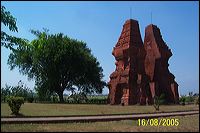 A
new type of structure which appeared during the
Majapahit era was the Bentar temple, or split
gateway. As to the origin of this form, there
is no certain answer. The earliest known example,
of which only the foundation remains, appears
to come from the complex of Penataran temple.
Dates equivalent to the year A.D. 1320 are inscribed
on two stone guardian figures which seem to have
been connected with the gate. Another Bentar
temple, also in a ruined condition, can be seen
at Jawi temple. According to the Nagarakertagama,
this temple underwent reconstruction in 1331,
which implies the possibility that the gateway
was already in existence around the year 1300.
Yet the wording of the text is not clear enough
to draw a positive conclusion.
A
new type of structure which appeared during the
Majapahit era was the Bentar temple, or split
gateway. As to the origin of this form, there
is no certain answer. The earliest known example,
of which only the foundation remains, appears
to come from the complex of Penataran temple.
Dates equivalent to the year A.D. 1320 are inscribed
on two stone guardian figures which seem to have
been connected with the gate. Another Bentar
temple, also in a ruined condition, can be seen
at Jawi temple. According to the Nagarakertagama,
this temple underwent reconstruction in 1331,
which implies the possibility that the gateway
was already in existence around the year 1300.
Yet the wording of the text is not clear enough
to draw a positive conclusion.
One gateway of this type which
is still standing, and which is currently undergoing
restoration, is Wringinlawang temple (or Jatipasar),
located among the ruins at Trowulan. Wringinlawang
is generally considered to have been the entrance
gate to an important complex of buildings in
the Majapahit capital, but its exact age is unknown.
Bentar temple are also found
carved in relief on the walls of a number of
temples, notably at Jawi and Jajaghu. The latter,
which is known to have been the memorial shrine
to King Wishnuwardhana of Singosari (d. 1268),
invites the suggestion that these split gateways
must therefore have been in use as early as the
mid-thirteenth century. However, the style of
the reliefs suggests a later date than that of
the original monument, and they are thus considered
to have been carved during the reign of King
Hayam Wuruk of Majapahit. The conclusion to be
reached from all this is that Bentar temple
were almost certainly in use from at least the
early years of the 14th century.
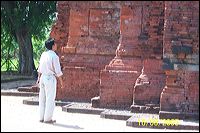 |
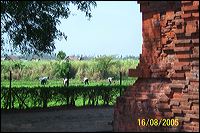 |
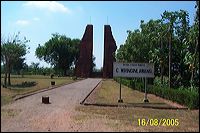 |
|---|
Kidal Temple
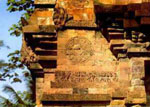 The
narrative poem Nagarakartagama identifies
Kidal temple as the burial shrine of King Anusapati,
who died in 1248. The temple may then be deted
around the middle of the 13th century. A statue
of shiwa, said to have come from Kidal and thus
assumed to be the portrait of Anusapati, is in
the possession of the Royal Tropical Institute
in Amsterdam.
The
narrative poem Nagarakartagama identifies
Kidal temple as the burial shrine of King Anusapati,
who died in 1248. The temple may then be deted
around the middle of the 13th century. A statue
of shiwa, said to have come from Kidal and thus
assumed to be the portrait of Anusapati, is in
the possession of the Royal Tropical Institute
in Amsterdam.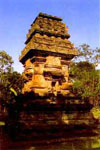 Kidal temple, located in Rejokodal village, south east of Malang. |
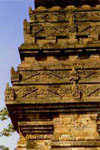 Kidal temple, a detail of the roof, now partially collapsed |
 Kidal temple, a scene from the Garudeya |
Singasari Temple
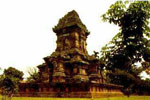 Candi
Singosari, located about 12 kilometres north
of Malang, is one of the monuments built in memory
of Kertanagara, last king of Singosari, who died
when his palace was seized by a usurper in 1292.
The temple was partially restored in the 1930's.
The roof, in its original state, would have mirrored
the cosmic Mt Mahameru of Hindu mythology, four
lesser pinnacles on each side surrounding a taller,
central 'peak'. Yet it seems that the temple
was never completed. The impressive kala heads,
highly detailed on the roof, become mere outlines
above the entrance and wall niches lower down,
showing that the fine carving was executed from
the top downwards. For unkown reasons, the artists
appear to have abandoned their work.
Candi
Singosari, located about 12 kilometres north
of Malang, is one of the monuments built in memory
of Kertanagara, last king of Singosari, who died
when his palace was seized by a usurper in 1292.
The temple was partially restored in the 1930's.
The roof, in its original state, would have mirrored
the cosmic Mt Mahameru of Hindu mythology, four
lesser pinnacles on each side surrounding a taller,
central 'peak'. Yet it seems that the temple
was never completed. The impressive kala heads,
highly detailed on the roof, become mere outlines
above the entrance and wall niches lower down,
showing that the fine carving was executed from
the top downwards. For unkown reasons, the artists
appear to have abandoned their work.
West of the temple, at a distance of some 200
metres, two enormous guardian figures stand on
either side of the road. It has been suggested
that the location of these statues may be the
site of the original entrance to the palace of
Singosari.
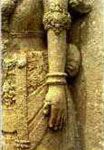 |
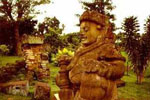 One of two guardian figures (dwarapala), measuring almost 4 m. tall |
 |
Tidak ada komentar:
Posting Komentar